Related Research Articles
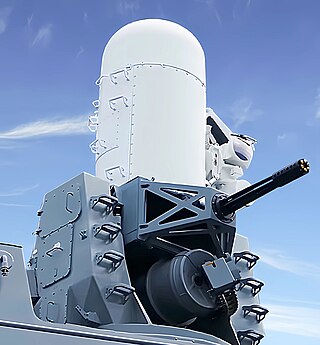
The Phalanx CIWS is a gun-based close-in weapon system to defend military watercraft automatically against incoming threats such as aircraft, missiles, and small boats. It was designed and manufactured by the General Dynamics Corporation, Pomona Division, later a part of Raytheon. Consisting of a radar-guided 20 mm (0.8 in) Vulcan cannon mounted on a swiveling base, the Phalanx has been used by the United States Navy and the naval forces of 15 other countries. The US Navy deploys it on every class of surface combat ship, except the Zumwalt-class destroyer and San Antonio-class amphibious transport dock. Other users include the British Royal Navy, the Royal Australian Navy, the Royal New Zealand Navy, the Royal Canadian Navy and the US Coast Guard.
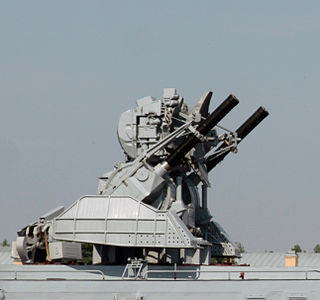
A close-in weapon system is a point-defense weapon system for detecting and destroying short-range incoming missiles and enemy aircraft which have penetrated the outer defenses, typically mounted on a naval ship. Nearly all classes of larger modern warships are equipped with some kind of CIWS device.

The Type 051B destroyer is a class of destroyer built by the People's Republic of China. It consists of only one ship, Shenzhen (167). When Shenzhen was commissioned into the People's Liberation Army Navy Surface Force in 1998, it was then the largest surface combatant that China had ever built. It resembles in many ways an enlarged version of the Luhu-class destroyer, and is one of the first PLAN ships with a slope-sided hull to reduce radar signature. The Type 051B was succeeded by the domestic Type 052B destroyer, discounting the 4 Soviet-built Sovremenny-class destroyer that China purchased in the interim.

The OTO Melara 76 mm gun is a naval gun built and designed by the Italian defence company OTO Melara. It is based on the OTO Melara 76/62C and evolved toward 76/62 SR and 76/62 Strales.

The AK-630 is a Soviet and Russian fully automatic naval, rotary cannon, close-in weapon system. The "630" designation refers to the weapon's six gun barrels and their 30 mm caliber.

Conical scanning is a system used in early radar units to improve their accuracy, as well as making it easier to steer the antenna properly to point at a target. Conical scanning is similar in concept to the earlier lobe switching concept used on some of the earliest radars, and many examples of lobe switching sets were modified in the field to conical scanning during World War II, notably the German Würzburg radar. Antenna guidance can be made entirely automatic, as in the American SCR-584. Potential failure modes and susceptibility to deception jamming led to the replacement of conical scan systems with monopulse radar sets. They are still used by the Deep Space Network for maintaining communications links to space probes. The spin-stabilized Pioneer 10 and Pioneer 11 probes used onboard conical scanning maneuvers to track Earth in its orbit.

The Type 730 is a Chinese seven-barrelled 30 mm Gatling gun/Rotary cannon CIWS. It has a PLA Navy designation H/PJ12. It is mounted in an enclosed automatic turret and directed by radar, and electro-optical tracking systems. The maximum rate of fire is 5800 rd/m, and the effective range is up to 3 km.

DARDO is a close-in weapon system (CIWS) built by the Italian companies Breda and Oto Melara. It is composed of two Breda-built Bofors 40 mm firing high explosive (HE) shells, a fire-control radar (RTN-10X) and a fire-control system. It is the last of a long series of Italian anti-aircraft weapons derived from the Swedish Bofors 40 mm autocannons.

The Type 345 (MR35) fire-control radar system is used to guide the HQ-7 short-range surface-to-air missile. The system is installed on many modern, and retrofitted Chinese navy ships.

The Type 344 is a multifunctional fire control radar (FCR) developed by the Xian Research Institute of Navigation Technology (西安导航技术研究所)/XRINT/ No. 20th Research Institute.
Type 348 radar is a Chinese fire control radar developed for Type 76 twin 37 mm naval gun as CIWS, and it incorporates features of Italian RTN-10X and RTN-20X sold to China in 1992. Type 348 radar is frequently but erroneously confused and misidentified as another Chinese naval radar Type 346 due to the lack of publicized information in the development of the latter.

The People's Liberation Army Navy Surface Force is the surface warfare branch of China's People's Liberation Army Navy (PLAN), consisting of all surface vessels in operational service with the PLAN. The PLAN Surface Force operates 661 ships organized into three fleets: the North Sea Fleet, the East Sea Fleet and the South Sea Fleet.
The Type 362 is an air/surface search radar and was first displayed at ASIANDEX 1988 and in its original guise have only been installed on the Luhu class DDG, Luda class DDG 166 and selected Jianghu FFGs.
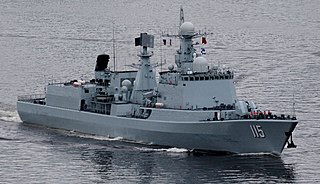
The Type 051C destroyer is a long-range air-defence guided-missile destroyer built by China in its ongoing effort to create a true blue water navy. The ship uses the hull design of the older Type 051B, but is equipped with the advanced Russian S-300FM air defence missiles systems. Currently, two ships of this class have been launched and deployed by People's Liberation Army Navy North Sea Fleet.
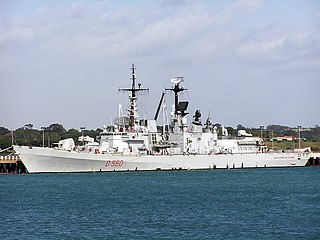
The Durand de la Penne class are two guided-missile destroyers operated by the Italian Navy. The design is an enlarged version of the Audace class, updated with diesel and gas turbine CODOG machinery and modern sensors. Four ships were planned but the second pair were cancelled when Italy joined the Horizon project.
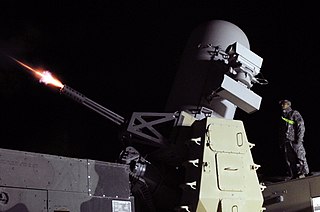
Counter rocket, artillery, and mortar, abbreviated C-RAM or counter-RAM, is a set of systems used to detect and/or destroy incoming rockets, artillery, and mortar rounds in the air before they hit their ground targets, or simply provide early warning.

The Iowa-class battleships are the most heavily armed gunships the United States Navy has ever put to sea, due to the continual development of their onboard weaponry. The first Iowa-class ship was laid down in June 1940; in their World War II configuration, each of the Iowa-class battleships had a main battery of 16-inch (406 mm) guns that could hit targets nearly 20 statute miles (32 km) away with a variety of artillery shells designed for anti-ship or bombardment work. The secondary battery of 5-inch (127 mm) guns could hit targets nearly 9 statute miles (14 km) away with solid projectiles or proximity fuzed shells, and was effective in an anti-aircraft role as well. Each of the four battleships carried a wide array of 20 mm and 40 mm anti-aircraft guns for defense against enemy aircraft.

The Adhafer-class corvette is a type of stealth corvette belonging to the Algerian Navy. They are built in China by China State Shipbuilding Corporation CSSC in its Hudong-Zhonghua shipyard in Shanghai. The ship is 120 metres long and 14.4 metres wide and has a standard displacement of 2,880 tons. Three Adhafer-class ships were commissioned, with an option for three others of the same type. The first unit was launched on 15 August 2014 and commissioned in November 2015. The second and third were both commissioned in 2016.
Type LR66 radar is a Chinese fire control radar or Type 349 for Type 730 CIWS developed by the 20th Research Institute of China Electronics Technology Group Corporation , also known as Xi’an Research Institute of Navigation Technology (西安导航技术研究所).
Type 349 radar is a fire-control radar for Type 730 CIWS developed by the 20th Research Institute of China Electronics Technology Group Corporation , also known as Xi’an Research Institute of Navigation Technology (西安导航技术研究所), with the Chinese naval designation of H/LJP-349. In addition to CIWS, Some models of Type 349 is also used to control larger caliber guns.
References
- ↑ "TYPE 76A (DUAL-37MM) SHIPBOARD ANTIAIRCRAFT ARTILLERY". Archived from the original on 2006-10-21.
- ↑ "Radar" . Retrieved July 5, 2016.
- 1 2 3 "Type 347 Radar" . Retrieved July 5, 2016.